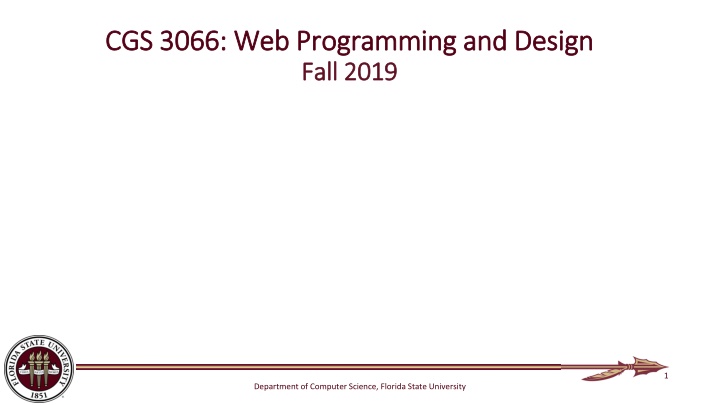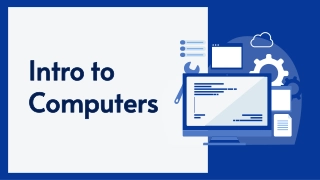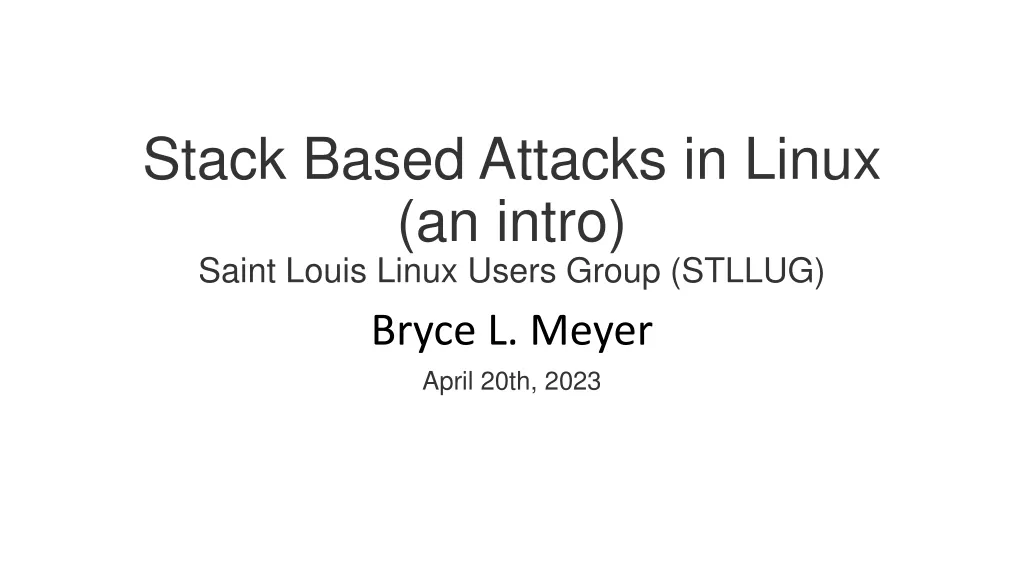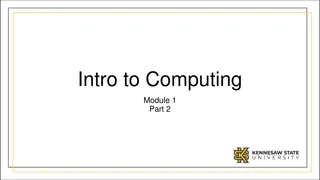
Web Programming and Design Course Overview Fall 2019
"Learn internet communication, web design, development, and scripting in the CGS 3066 Web Programming and Design course at Florida State University. Covering HTML, CSS, JavaScript, PHP, SQL, and more. Understand course structure, grading system, textbook recommendation, and required software for assignments on CS webserver."
Download Presentation

Please find below an Image/Link to download the presentation.
The content on the website is provided AS IS for your information and personal use only. It may not be sold, licensed, or shared on other websites without obtaining consent from the author. If you encounter any issues during the download, it is possible that the publisher has removed the file from their server.
You are allowed to download the files provided on this website for personal or commercial use, subject to the condition that they are used lawfully. All files are the property of their respective owners.
The content on the website is provided AS IS for your information and personal use only. It may not be sold, licensed, or shared on other websites without obtaining consent from the author.
E N D
Presentation Transcript
CGS 3066: Web Programming and Design CGS 3066: Web Programming and Design Fall 2019 Fall 2019 1 Department of Computer Science, Florida State University
Course Information Instructor: Md Mainuddin Class time: Mondays and Wednesdays, 5:15 - 6:30 PM at LOV 301 Office: 101A MCH (Carothers) Building Office Hours: Wednesday 4:00pm 5:00pm, Thursday 4:00pm 6pm Email: mm15ar@my.fsu.edu Course Site: http://www.cs.fsu.edu/~cgs3066/
Textbook Not required Optional/Recommended: Internet & World Wide Web How to Program, 5thedition, Paul J. Deitel, Harvey M. Deitel, Abbey Deitel. ISBN 0-13-215100-6
Overview This course involves an overview of Internet communications and information services as well as technologies on which the Internet and Web are built. It focuses on Web design, development, and scripting with participants learning the latest tools and techniques for building professional-grade, dynamic, and interactive web pages and sites.
Web languages/technologies to be covered HTML 5 CSS Javascript PHP SQL Ajax/XML
Grading 10% - Quiz/Class participation 40% - Homeworks 25% - Term Project 25% - Final exam
WW2 accounts We will use CS webserver to upload and assess the assignments Students are eligible for user account at WW2 webserver of the Computer Science Department (ww2.cs.fsu.edu) Need to sign up for a CS account first https://system.cs.fsu.edu/newuser/cs-account-setup/ Once the CS account is set up, send me an email with your username, with subject CGS-3066 Account Setup
Homeworks/Project should be uploaded to CS WW2 account Required software: Web server setup at localhost use XAMPP or similar text editor. e.g. Notepad, Notepad++, vi, Sublime Text MySQL Client (MySQL Workbench, Heidi SQL, or similar) web browser To upload files Use Filezilla, Tectia (https://system.cs.fsu.edu/newuser/ssh- how-to/), or any other ftp client.
Internet and the World Wide Web Internet network of globally connected computers All the computers can communicate with each other TCP/IP protocol for primary communication Many Applications, each having own overlay of protocols
Internet and the World Wide Web(contd) World Wide Web(WWW) A system of global information sharing through Internet Information represented, shared in Hypertexts, more commonly known as Web Pages Uses a client-server model of communication All computers on WWW use a protocol called HTTP to communicate
Client-server model in WWW Web pages are stored in Web Servers Clients request for web pages through Web Browsers Browser makes an HTTP request, specified by a URL/Web Address (i.e. http://www.cs.fsu.edu/~cgs3066/index.html) Server reads the address, returns corresponding contents through HTTP Contents received is written in HTML, rendered by browser into a web page
Example of Clients and Servers Web server Apache NginX MS IIS Client (browsers) Google Chrome Mozilla Firefox Microsoft Edge/Internet Explorer
Client-side Server-side All the processing done by your browser (or the client in your device) Al the processing done inside a web server Request dispatching Database queries Communication with other systems/APIs HTML and CSS rendering Client-side JavaScript Also called front-end Also called back-end JS libraries and frameworks jQuery, React.js, Angular, Vue, Backbone PHP, Java, ASP.NET, Ruby, Node JS, Python
HTML stands for Hyper Text Markup Language HTML is a markup language A markup language is a set of markup tags The tags describe document content HTML documents contain HTML tags and plain text
HTML by itself has limited formatting capabilities Styles define how to display HTML elements CSS stands for Cascading Style Sheets External Style Sheets can save a lot of work External Style Sheets are stored in CSS files
h1{ color:orange; text-align:center; } p{ font-family:"Times New Roman"; font-size:20px; }
JavaScript is the programming language of the Web. HTML to define the content of web pages CSS to specify the layout of web pages JavaScript to program the behavior of web pages. document.getElementById("demo"). innerHTML = "Hello JavaScript";
PHP is a server scripting language PHP is a powerful tool for making dynamic and interactive Web pages quickly. PHP files can contain text, HTML, CSS, JavaScript, and PHP code PHP code are executed on the server, and the result is returned to the browser as plain HTML
<!DOCTYPE html> <html> <body> <?php echo date( Y-m-d ); ?> 2019-08-26 </body> </html>
Data used as web contents are often stored in separate databases Upon HTTP request, Web server needs to access the database Done by PHP/server-side scripts SQL is a standard language for accessing databases Different Implementations: MySQL, PostgreSQL, SQLite










